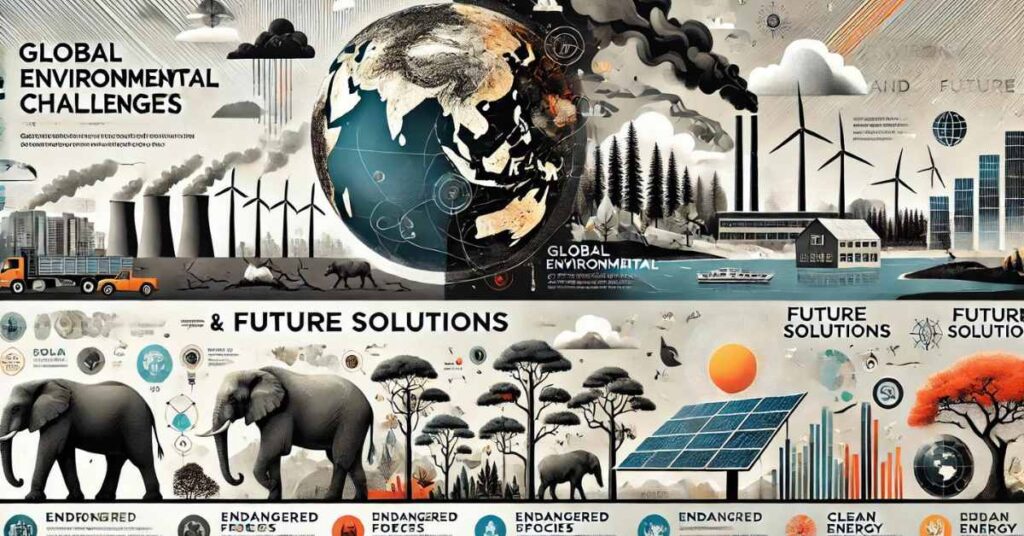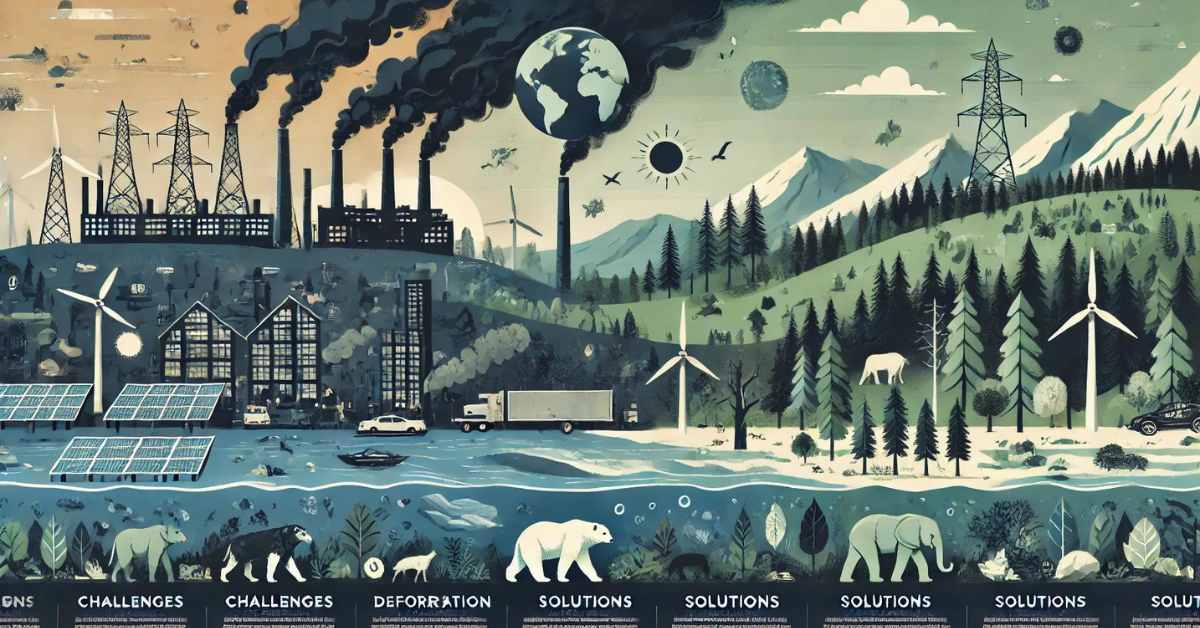The environment forms the basis of all life on Earth. It includes everything from the air we breathe to the water we drink, the soil beneath our feet, and the ecosystems that support biodiversity. As human activities have intensified, we face a global environmental crisis that requires urgent action. This environment one pager aims to provide a concise yet comprehensive look at the critical environmental issues we face today, their causes, and potential solutions.
The State of the Global Environment
The health of our environment has significantly deteriorated over the past century. Human activities, particularly industrialization, urbanization, and agricultural expansion, have led to widespread environmental degradation. In this environment one pager, we will explore the key challenges, including climate change, deforestation, pollution, and biodiversity loss.
Climate Change
Climate change is one of the most urgent environmental issues today. Driven primarily by the burning of fossil fuels, deforestation, and industrial processes, greenhouse gases such as carbon dioxide (CO2) and methane (CH4) are accumulating in the atmosphere. This traps heat and leads to global warming, with far-reaching consequences such as rising sea levels, more frequent and severe weather events, and disruptions to ecosystems.
In this environment one pager, it’s crucial to highlight that climate change not only threatens natural habitats but also human livelihoods. Coastal communities are particularly vulnerable, with flooding, erosion, and saltwater intrusion threatening homes and agricultural lands.
Deforestation
Forests play a vital role in regulating the Earth’s climate by absorbing CO2, maintaining biodiversity, and providing livelihoods for millions of people. However, deforestation, primarily driven by agriculture, logging, and infrastructure development, continues at an alarming rate. This environment one pager emphasizes that deforestation not only contributes to climate change by releasing stored carbon but also results in habitat loss and species extinction.
The Amazon rainforest, often referred to as the “lungs of the Earth,” is a prime example of how deforestation is pushing ecosystems toward collapse. Protecting forests is critical to slowing climate change and preserving biodiversity.
Pollution
Pollution, in its many forms, is another major environmental concern. Air pollution from vehicles, factories, and the burning of fossil fuels contributes to respiratory diseases and premature deaths. Water pollution, resulting from industrial runoff, agricultural chemicals, and plastic waste, threatens aquatic ecosystems and contaminates drinking water supplies.
In this environment one pager, addressing the issue of plastic pollution is crucial. An estimated 8 million tons of plastic enter the oceans every year, posing significant risks to marine life, human health, and food security.
Biodiversity Loss
Biodiversity, or the variety of life on Earth, is essential for ecosystem resilience and human survival. However, habitat destruction, climate change, pollution, and overexploitation of species are causing unprecedented rates of biodiversity loss. This environment one pager underscores that one million species are currently at risk of extinction, according to the United Nations, which will have cascading effects on ecosystems and the services they provide, such as pollination, water purification, and disease regulation.
The Causes of Environmental Degradation
Understanding the root causes of environmental degradation is essential to addressing the crisis effectively. This environment one pager highlights the key drivers behind the environmental challenges we face today.
Industrialization and Energy Consumption
The industrial revolution marked the beginning of a new era of human development, but it also initiated a period of intense environmental damage. The reliance on fossil fuels—coal, oil, and natural gas—has powered economic growth for over two centuries, but at the cost of air and water pollution, greenhouse gas emissions, and habitat destruction.
In this environment one pager, it is important to recognize that transitioning to renewable energy sources, such as solar, wind, and hydroelectric power, is a critical step in reducing the environmental impact of energy consumption.
Agriculture and Land Use Change
Agriculture is another major contributor to environmental degradation. Practices such as monoculture farming, overgrazing, and the use of chemical fertilizers and pesticides degrade soil quality, reduce biodiversity, and contribute to water pollution. Additionally, the conversion of forests and wetlands into agricultural land accelerates deforestation and habitat loss.
This environment one pager emphasizes the need for sustainable agriculture practices, such as crop rotation, agroforestry, and organic farming, to mitigate the environmental impact of food production.
Overconsumption and Waste
Human consumption patterns are unsustainable, with resource extraction, manufacturing, and waste generation contributing to environmental degradation. The linear “take-make-dispose” economic model leads to the depletion of natural resources and the accumulation of waste, particularly plastic waste, which persists in the environment for hundreds of years.
This environment one pager highlights the importance of shifting toward a circular economy, where resources are reused, recycled, and regenerated, reducing the strain on the environment.
The Impacts of Environmental Degradation
The consequences of environmental degradation are far-reaching and affect every aspect of life on Earth. This environment one pager details the significant impacts on ecosystems, human health, and economies.
Ecosystem Disruption
Ecosystems are highly interconnected, and disruptions to one part of the system can have cascading effects. For example, the loss of pollinators due to pesticide use and habitat destruction threatens food security, as many crops depend on pollination. Similarly, deforestation and land degradation reduce the capacity of ecosystems to sequester carbon, worsening climate change.
This environment one pager stresses that ecosystem disruption diminishes the planet’s ability to provide essential services, such as clean water, air, and fertile soil.
Human Health
Environmental degradation has direct and indirect impacts on human health. Air and water pollution contribute to respiratory diseases, cancer, and waterborne illnesses. Extreme weather events, intensified by climate change, lead to injuries, loss of life, and displacement of communities.
Moreover, as outlined in this environment one pager, the loss of biodiversity increases the risk of zoonotic diseases—diseases that are transmitted from animals to humans—such as COVID-19. Protecting natural habitats and maintaining biodiversity are essential for reducing the risk of future pandemics.
Economic Costs
Environmental degradation imposes significant economic costs. Climate-related disasters, such as hurricanes, floods, and droughts, cause billions of dollars in damages each year. Degraded ecosystems are less productive, leading to lower agricultural yields, fisheries collapse, and reduced tourism revenue.
This environment one pager also highlights the fact that transitioning to a green economy, which prioritizes sustainability, can create jobs, stimulate innovation, and reduce long-term economic risks.

Solutions to Environmental Challenges
Despite the daunting scale of the environmental crisis, there are solutions that can mitigate the damage and protect the planet’s future. This environment one pager presents some of the key strategies for addressing environmental degradation.
Renewable Energy Transition
A shift from fossil fuels to renewable energy sources is essential for reducing greenhouse gas emissions and curbing climate change. Solar, wind, and hydroelectric power are becoming increasingly affordable and accessible, offering clean alternatives to traditional energy sources.
This environment one pager underscores the importance of investment in renewable energy infrastructure, along with policy support for carbon pricing and emissions reduction targets.
Sustainable Agriculture
Sustainable agriculture practices are critical for protecting ecosystems while ensuring food security. Techniques such as agroecology, permaculture, and regenerative farming work with nature rather than against it, improving soil health, reducing water use, and enhancing biodiversity.
By promoting sustainable agriculture in this environment one pager, we can help reduce the environmental impact of food production and build resilience to climate change.
Circular Economy
A circular economy offers a transformative solution to the problem of overconsumption and waste. In a circular economy, materials are kept in use for as long as possible, and products are designed to be reused, repaired, and recycled. This reduces the need for resource extraction and minimizes waste generation.
This environment one pager highlights the importance of adopting circular economy principles across industries to create a more sustainable future.
Conservation and Restoration
Protecting natural habitats and restoring degraded ecosystems are essential for halting biodiversity loss and mitigating climate change. Conservation efforts focus on protecting key ecosystems, such as forests, wetlands, and coral reefs, while restoration initiatives aim to rehabilitate areas that have been damaged by human activity.
This environment one pager calls for increased funding and support for conservation projects, as well as community-led restoration efforts.
The Role of Individuals and Communities
While governments and corporations play a significant role in addressing environmental challenges, individual and community actions are equally important. This environment one pager outlines practical steps that individuals can take to reduce their environmental footprint.
Reducing Energy Consumption
Individuals can reduce their energy consumption by adopting energy-efficient technologies, such as LED lighting and energy-saving appliances. Additionally, using public transportation, walking, or cycling instead of driving can help lower greenhouse gas emissions.
Supporting Sustainable Products
Choosing products that are sustainably sourced, ethically produced, and made from recycled materials is another way individuals can make a positive impact. This environment one pager encourages consumers to be mindful of their purchasing decisions and to support companies that prioritize environmental sustainability.
Participating in Local Conservation Efforts
Community-led conservation initiatives, such as tree planting, habitat restoration, and clean-up projects, provide an opportunity for individuals to contribute to environmental protection. By engaging with local organizations and participating in environmental stewardship, individuals can help protect their natural surroundings.
Conclusion: A Path Forward for the Environment
The environmental challenges we face are complex and interrelated, but they are not insurmountable. This environment one pager emphasizes that by understanding the key issues—climate change, deforestation, pollution, and biodiversity loss—and taking decisive action, we can protect the planet for future generations.
It will require global cooperation, innovative solutions, and a commitment to sustainability from individuals, businesses, and governments alike.

